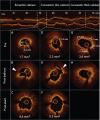The Value of Intracoronary Imaging and Coronary Physiology When Treating Calcified Lesions
- PMID: 31867063
- PMCID: PMC6918501
- DOI: 10.15420/icr.2019.16.R1
The Value of Intracoronary Imaging and Coronary Physiology When Treating Calcified Lesions
Abstract
Heavily calcified coronary artery lesions hinder the delivery of devices and limit stent expansion, resulting in low procedural success and poor clinical outcomes driven by an increase in restenosis and stent thrombosis. Intracoronary imaging provides a more precise assessment of lesions and is a critical step when deciding whether the lesion needs to be prepared with atherectomy devices. Physiological assessment of lesion significance is an important consideration to avoid unnecessary stenting. This article summarises the current data on the value of intracoronary imaging and functional assessment for coronary calcified lesions and suggests a treatment strategy based on the findings of intracoronary imaging findings.
Keywords: Calcified lesion; fractional flow reserve; intravascular ultrasound; optical coherence tomography; rotablation.
Copyright © 2019, Radcliffe Cardiology.
Conflict of interest statement
Disclosure: LR has received research grants from Abbott, Biotronik, HeartFlow, Sanofi and Regeneron, and speaker fees from Abbott, Amgen, AstraZeneca, Bayer, Biotronik, CSL Behring and Sanofi. He is also an unpaid principal investigator of a first in-man study conducted by Biotronik. All other authors have no conflicts of interest to declare.
Figures






References
Publication types
LinkOut - more resources
Full Text Sources

